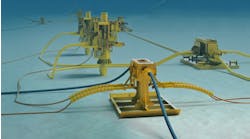Offshore staff
HOUSTON – Growing demand for energy and for petroleum products will spur offshore activity in the near term and the upstream oil and gas industry needs to be ready to answer that need, said Gerbert Schoonman, Vice President, Global Production—Offshore, Hess Corp., at the Offshore Technology Conference on Thursday.
In his presentation entitled “Keeping the Faith,” Schoonman stated that offshore and deepwater will remain critical to meeting future energy demand.
Schoonman noted that credible long-term energy forecasts predict that global energy demand will grow by about 25% by 2040. “The energy mix will change, and the use of renewables will grow,” Schoonman said. But oil demand will also be growing as part of that mix, “and offshore oil is a growth business.”
He noted that upstream investment has declined by 40% since 2014, and while onshore shale production has stepped in to fill a production void, “it won’t be enough” going forward, Schoonman said. “Offshore has a key role to play in meeting future demand.”
The global oil and gas industry will need to invest $6 trillion in offshore development by 2040 to meet future demand, Schoonman said. “We will have to add twice what the US is producing now,” he predicted. Some $200 to $250 billion/year will need to be invested in the global offshore market to do that, he said, including shallow-water, deepwater, and ultra-deepwater fields.
Going forward, Schoonman said that it will be vitally important for operators to maintain their investments, both onshore and offshore, and throughout the cycles of price fluctuations that inevitably occur.
The offshore market, he added, currently benefits from some “compelling economics.” He noted that while the onshore Bakken play has breakevens of $55/bbl, the offshore Liza discovery has a breakeven of $40/bbl.
Schoonman conceded that at present, there are not too many new projects being developed in the Gulf of Mexico. “But we have the opportunity to change that,” he said. New seismic technologies are can image hydrocarbon reserves below the salt layers, drilling costs have come down, and operators are turning to standardized production facilities. With these new technologies and cost efficiencies now in play, “we think that there will be a lot of projects in the Gulf of Mexico in the future.”
“We are optimistic about the Gulf,” Schoonman said. He noted that Hess has been among the top 5 players in the last two lease rounds in the US Gulf of Mexico, in terms of acquiring acreage. “So we are putting our money where our mouth is.”
He also noted that Hess continued to develop a number of offshore projects even in the midst of the downturn: Tubular Bells and Stampede in the Gulf of Mexico; North Malay Basin in the Gulf of Thailand; and the Liza project offshore Guyana.
At present, drilling and other work is continuing at the Tubular Bells field, and at the nearby Esox prospect in the Gulf of Mexico. If successful, the Esox prospect could become another high-return tieback for Hess, Schoonman said.
He also noted that the three offshore projects that Hess has brought onstream in recent years – Tubular Bells, Stampede, and North Malay Basin – are now generating positive cashflow. Hess has been able to keep the projects moving and profitable, he said, through its “lean” approach to field development and operations. This approach has enabled Hess to work with the vendors and contractors in its supply chain to improve safety, quality, delivery and reduce costs.
Hess is now in Phase 2 of its North Malay Basin project, and the platforms and production facilities now being constructed as part of this phase are benefiting from this lean approach, Schoonman said.
Schoonman also noted that Hess has been able to reduce the cycle times of its wells significantly on both the North Malay Basin and Stampede projects, and had also been able to reduce non-productive time on rigs.
“But driving efficiency alone is not enough,” Schoonman said. “We also need innovation.” As an example, he noted that fracking and horizontal well technologies have fundamentally changed the industry. “Technology and innovation will continue to be disruptive,” he observed.
That disruptive technology, he noted, will likely come from outside of the oil and gas industry. “We have to watch what’s going on in robotics, artificial intelligence and machine learning,” he said. In particular, Schoonman predicted that the “autonomous field of the future” will be made possible by AUVs and unmanned platforms. In the future, these types of new technologies and production systems will make smaller and more remote offshore fields economic.
“We believe in offshore and we believe in the Gulf of Mexico,” Schoonman said in his concluding remarks.
5/11/2019


